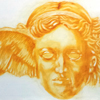
An Explanation on the Design of the Lovers Major Arcana Tarot Card
0 likes
Lovers from Tarot of the Morning Star
Inspiration for my depiction of the Lovers tarot card came in part from Paolo Uccello’s painting of Saint George and the Dragon.
On first view, of Paolo Uccello’s painting it appears the male hero is liberating the maiden from the dragon. However, on closer scrutiny, it can be seen that the maiden holds and leads the dragon by the chain around its neck. The dragon is not her jailor but her pet.
The maiden is the symbolic stimulus for overcoming fear for she inflames the hero to action liberating him from what holds him back as represented by the dragon.
It is not the maiden who is liberated but the male when his desire for her is strong enough to overcome his fear.
See Tarot Lovers Relative to Bicameral Mind Theory
0 likes

